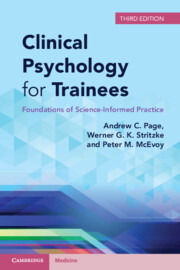Book contents
- Clinical Psychology for Trainees
- Clinical Psychology for Trainees
- Copyright page
- Contents
- Chapter 1 A Science-Informed Model of Clinical Psychology Practice
- Chapter 2 Relating with Clients
- Chapter 3 Assessing Clients
- Chapter 4 Matching Treatments and Monitoring Client Progress
- Chapter 5 Linking Assessment to Treatment: Case Formulation
- Chapter 6 Treating Clients
- Chapter 7 Brief Interventions
- Chapter 8 Low-Intensity Psychological Interventions
- Chapter 9 Group Treatment
- Chapter 10 Programme Evaluation
- Chapter 11 Case Management
- Chapter 12 Supervision
- Chapter 13 Managing Ruptures in Therapeutic Alliance
- Chapter 14 Respecting the Humanity of Clients: Cross-Cultural and Ethical Aspects of Practice
- Chapter 15 Providing Therapy at a Distance and Working in Rural and Remote Settings
- Chapter 16 Psychologists as Health Care Providers
- Chapter 17 Working in Private Practice – Dr Clair Lawson; Clinical Psychologist and Director; Lawson Clinical Psychology
- References
- Index
Chapter 6 - Treating Clients
Published online by Cambridge University Press: 14 April 2022
- Clinical Psychology for Trainees
- Clinical Psychology for Trainees
- Copyright page
- Contents
- Chapter 1 A Science-Informed Model of Clinical Psychology Practice
- Chapter 2 Relating with Clients
- Chapter 3 Assessing Clients
- Chapter 4 Matching Treatments and Monitoring Client Progress
- Chapter 5 Linking Assessment to Treatment: Case Formulation
- Chapter 6 Treating Clients
- Chapter 7 Brief Interventions
- Chapter 8 Low-Intensity Psychological Interventions
- Chapter 9 Group Treatment
- Chapter 10 Programme Evaluation
- Chapter 11 Case Management
- Chapter 12 Supervision
- Chapter 13 Managing Ruptures in Therapeutic Alliance
- Chapter 14 Respecting the Humanity of Clients: Cross-Cultural and Ethical Aspects of Practice
- Chapter 15 Providing Therapy at a Distance and Working in Rural and Remote Settings
- Chapter 16 Psychologists as Health Care Providers
- Chapter 17 Working in Private Practice – Dr Clair Lawson; Clinical Psychologist and Director; Lawson Clinical Psychology
- References
- Index
Summary
After assessing a client a treatment plan is required. The chapter outlines the practical steps in proceeding from a case formulation to a treatment plan. Since many techniques are modified for application in many different clinical problems and psychological disorders, we will concentrate on providing a description of particular procedures that are broadly applicable. The chapter provides practical illustrations of treatment planning with outlines of behaviour therapy, dialectical behaviour therapy, cognitive therapy, and interpersonal psychotherapy. It includes specific examples of clinical cases and explains how these approaches can be subsumed under a transdiagnostic framework of treatment planning. Consideration of transdiagnostic interventions involves targeting negative affect, intolerance of uncertainty, anxiety sensitivity, avoidance and safety behaviours, emotion regulation, and metacognitve therapy.
Keywords
- Type
- Chapter
- Information
- Clinical Psychology for TraineesFoundations of Science-Informed Practice, pp. 96 - 127Publisher: Cambridge University PressPrint publication year: 2022

